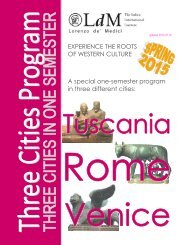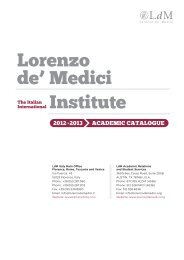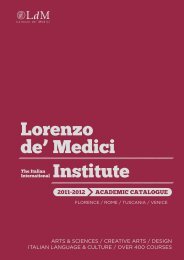aCademiC Catalog 2013-2014 - Lorenzo de Medici
aCademiC Catalog 2013-2014 - Lorenzo de Medici
aCademiC Catalog 2013-2014 - Lorenzo de Medici
Create successful ePaper yourself
Turn your PDF publications into a flip-book with our unique Google optimized e-Paper software.
with other approaches and wish to improve their technical skills<br />
through class exercises. Stu<strong>de</strong>nts will work on in<strong>de</strong>pen<strong>de</strong>nt<br />
projects focusing on subject matter from observation and<br />
reference to personal issues. The course is <strong>de</strong>signed to introduce<br />
stu<strong>de</strong>nts to more sophisticated and critical approaches to<br />
their chosen areas of focus in the context of contemporary<br />
sculpture. Project work will revolve around given themes, and<br />
stu<strong>de</strong>nts will be taken through a process of how to <strong>de</strong>velop<br />
their projects. The course covers work in clay, wire and plaster,<br />
casting from plaster and flexible molds in gesso, wax and paper.<br />
Structured exercises to assist the stu<strong>de</strong>nts will be given so that<br />
they will be able to better interpret relevant concepts.<br />
Prerequisites: SCU 160 Introductory Sculpture, or equivalent<br />
Ceramics: Majolica and Porcelain<br />
SCU 290 F<br />
Cr: 3; Contact hrs: 90<br />
When porcelain pottery arrived from China to Italy in the<br />
sixteenth century, artists tried to discover the secret of this<br />
beautiful white material, but it was not possible to do so because<br />
Italian lands were naturally poor in kaolin, the main compound<br />
in porcelain clay. As a result Italians <strong>de</strong>veloped competing<br />
products to meet the <strong>de</strong>mand of a market enchanted with white<br />
and blue Ming porcelain: firstly a blue and white majolica, and<br />
then a clay mixture that is not real porcelain. This mixture was<br />
created in a ceramic studio in Boboli Gar<strong>de</strong>ns in Florence and is<br />
known as “Porcellana Medicea”. In this practical and theoretical<br />
course stu<strong>de</strong>nts explore majolica and porcelain, two almost<br />
opposite materials: their quality of expression, their value, their<br />
technical aspects, their differences in historical context and<br />
their potential as creative media. Stu<strong>de</strong>nts un<strong>de</strong>rtake written<br />
work as well as practical projects using majolica and porcelain,<br />
and there will be visits to some of the exceptional centres of<br />
ceramic collecting and production in Florence and beyond.<br />
Prerequisites: SCU 130 Ceramics or SCU 160 Introductory<br />
Sculpture, or equivalent<br />
School of Creative Arts FLORENCE<br />
Advanced Sculpture<br />
SCU 360 F<br />
Cr: 3; Contact hrs: 90<br />
This course is <strong>de</strong>signed for stu<strong>de</strong>nts who have covered the<br />
foundations and intermediate levels of figurative and object<br />
sculpture or who have worked with other approaches and<br />
wish to improve their technical skills through class exercises.<br />
The course will continue the process of a more sophisticated<br />
and critical approach to one’s chosen conceptual and personal<br />
issues of focus in the context of contemporary sculpture.<br />
Project work will revolve around given themes, and stu<strong>de</strong>nts<br />
will be taken through a process of how to <strong>de</strong>velop these<br />
themes into a personal three-dimensional expressive language.<br />
The emphasis will be on work that <strong>de</strong>monstrates a high level<br />
of both technical and conceptual consi<strong>de</strong>rations. The course<br />
covers work in clay, wire and plaster, casting from plaster and<br />
flexible molds in gesso, wax and paper.<br />
Prerequisites: SCU 260 Intermediate Sculpture, or equivalent<br />
Advanced Sculpture (Summer only)<br />
SCU 361 F<br />
Cr: 3; Contact hrs: 60<br />
This course is <strong>de</strong>signed for stu<strong>de</strong>nts who have covered the<br />
foundations and intermediate levels of figurative and object<br />
sculpture or who have worked with other approaches and<br />
wish to improve their technical skills through class exercises.<br />
The course will continue the process of a more sophisticated<br />
and critical approach to one’s chosen conceptual and personal<br />
issues of focus in the context of contemporary sculpture.<br />
Project work will revolve around given themes, and stu<strong>de</strong>nts<br />
will be taken through a process of how to <strong>de</strong>velop these<br />
themes into a personal three-dimensional expressive language.<br />
The emphasis will be on work that <strong>de</strong>monstrates a high level<br />
of both technical and conceptual consi<strong>de</strong>rations. The course<br />
covers work in clay, wire and plaster, casting from plaster and<br />
flexible molds in gesso, wax and paper.<br />
Prerequisites: SCU 260 Intermediate Sculpture, or equivalent<br />
LdM Aca<strong>de</strong>mic <strong>Catalog</strong> <strong>2013</strong>-<strong>2014</strong><br />
101





